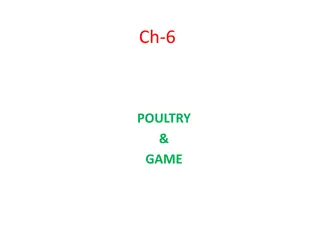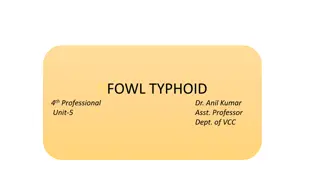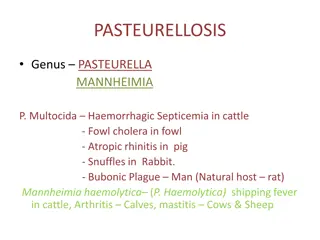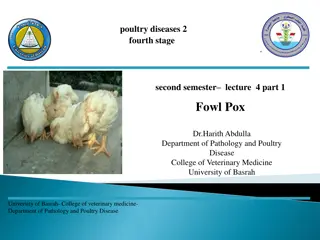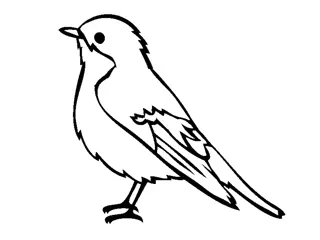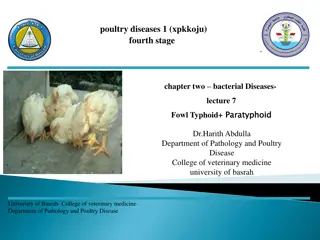Understanding Fowl Typhoid in Domestic Birds
Fowl Typhoid is a septicemic disease affecting domestic birds, characterized by acute and chronic phases, enlarged spleen, bronzy colored liver, and diarrhea. It is caused by Salmonella gallinarum and primarily affects young and adult chickens. The disease has a short incubation period of 4-5 days, high fever, greenish diarrhea, and a mortality rate of 75% in untreated flocks. Diagnosis involves similarities with Pullorum Disease, Paratyphoid Infections, and Fowl Cholera, with differentiation through laboratory tests.
Download Presentation

Please find below an Image/Link to download the presentation.
The content on the website is provided AS IS for your information and personal use only. It may not be sold, licensed, or shared on other websites without obtaining consent from the author. Download presentation by click this link. If you encounter any issues during the download, it is possible that the publisher has removed the file from their server.
E N D
Presentation Transcript
Fowl Typhoid is a septicemic disease of domestic birds, characterized by an acute and chronic phase , enlarged spleen , bronzy colored liver, and diarrhea with pasty vent. Etiology Etiology : : Salmonella gallinarum Susceptibility Susceptibility :Young and adult chickens are very susceptible.
1- Incubation period 4-5 days. 2- Course of disease about 5 days. 3- High fever. 4- Greenish diarrhea. 5- Mortality 75% in untreated flocks. 6- Comb and wattles : Pale and shrunken , in acute cases appeared dark.
1- Liver :Enlarged 2-3 times, bronzy color. Necrotic foci is evident in some cases. 2-Spleen :Enlarged 2-3 times of normal size, mottled, sometimes hemorrhagic. 3-Kidney :Enlarged, hard swelling and congested. 4-Oviduct :Appeared cooked. 5-Hemorrhagic ova,misshapen and discoloration. 6-Necrotic foci in the heart. 7-Intestine :Catarrhal inflammation. 8-Grayish-white foci may be observed in lungs, heart and gizzard.
Diagnosis Diagnosis: Similar to pullorum disease.
There are similarities with Pullorum Disease, Paratyphoid Infections and Fowl Cholera. For differentiation: 1-The marked congested and grossly enlarged liver and spleen. 2-Laboratory diagnosis. A-Cultivation and identification of the bacteria. B-Serological test : Agglutination test.






